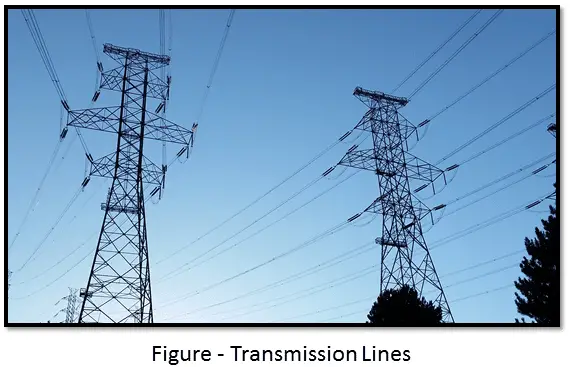The main difference between the transmission and distribution line is that the transmission line carries a large amount of power at high voltage, whereas a distribution power carries power at low voltage.
The electrical energy is produced at the generating stations such as thermal, gas, hydro, wind, solar power stations, etc. Since these generating stations are usually installed at a place far away from the point of utilization or consumers, there should be a means to transfer the electrical energy from generating station to the end user.
Therefore, we need to install electric power lines for conveying the electricity produced at the generating station to the points of utilization. This transmission of electrical power from generating point to the utilization point is performed in two stages namely transmission and distribution. Thus, the electric power lines can be classified into two categories:
- Transmission Lines
- Distribution Lines
We will learn about the transmission lines and distribution lines and the major differences between them in this article.
What is Transmission Line?
A transmission line is a high voltage power line that carries the electrical energy from generating stations to the electric substations. The transmission lines are also segmented into two sub-sections namely primary transmission lines and secondary transmission lines.

The primary transmission lines carry the electrical power from generating stations to the receiving stations, while the secondary transmission lines carry the electricity from receiving stations to the electrical substations. Then, further, the electrical substation distributes power to the end users.
The transmission line operates at very high voltages such as 33 kV, 66 kV, 132 kV, 220 kV, 440 kV, 765 kV, and so on. The steel towers are usually used to support the transmission lines.
What is Distribution Line?
As the name suggest, a distribution line is the power line that delivers electrical energy to the consumer’s load. Therefore, a power line that carries electrical energy from an electric substation to the consumer’s premises is known as a distribution line.

The distribution lines generally operate relatively at a lower voltage level, typically less than 33 kV. Like the transmission lines, the distribution lines are of two types namely primary distribution lines and secondary distribution lines.
The primary distribution lines carry the electrical power from substations to distribution stations (usually a transformer near the load point) and large consumers like factories and industries, while the secondary distribution lines carry the power from the distribution station to the load.
Differences between Transmission Line and Distribution Lines
Both transmission and distribution lines are used to convey the electricity to the load points. However, they are different from each other, the significant differences between them are listed in the below table.
| Parameter | Transmission Line | Distribution Line |
| Description | A high voltage power line that carries electrical energy from generating station to the electrical substation is known as a transmission line. | A power line that carries the electrical energy from the substation to the end consumers is known as a distribution line. |
| Voltage level | Transmission lines operate at higher voltages such as 33 kV, 66 kV, 132 kV, and more. | Distribution lines operate relatively at lower voltages, usually 11 kV or less. |
| Current-carrying capacity | It is designed to carry a large amount of current. Therefore, it has a large current carrying capacity. | It carries a low current and has a low current capacity. |
| Conductor size | The diameter of the conductor used in transmission lines is large. | The conductor diameter of distribution lines is relatively smaller. |
| Electricity flow | Depending on the grid connection, electricity can flow in bi-directions. | Distribution lines are usually unidirectional, i.e. electricity flows in one direction towards the load only. |
| Line length | Transmission lines carry the electricity over long distances. | Distribution lines carry the electricity over short distances such as within a city. |
| Phases | Transmission lines are three-phase lines only. | Distribution lines are three-phase or single-phase. The number of phases depends on the power delivering capacity of the line. It may also have 3 phase 4 wire system. |
| Types of line | There are three types of transmission lines. – Long transmission lines – Medium transmission lines – Short transmission lines | The distribution line has three categories. – Radial distribution lines – Ring distribution lines – Interconnected distribution lines |
| Line support | Large steel towers are usually used to support the transmission lines. | There are many types of supports used for distribution lines such as wooden poles, rail poles, RCC poles, etc. |
| Wire system | Transmission lines use a three-phase three-wire system for carrying electricity. | Distribution lines use both three-phase three-wire and three-phase four-wire systems. |
| Ground clearance | Transmission lines have high ground clearance because operate at very high voltages. | The ground clearance for distribution lines is comparatively less. |
Conclusion
Thus, the above table shows all the significant differences between transmission and distribution lines. Although, both transmission and distribution lines are crucial parts of any electric power system because they connect the generating plants to the loads.
Related Articles: